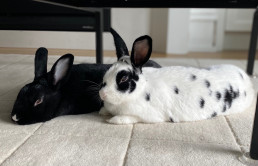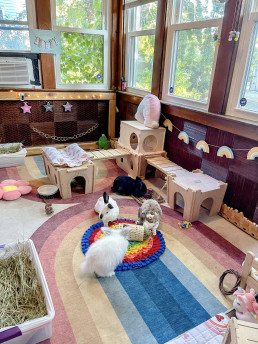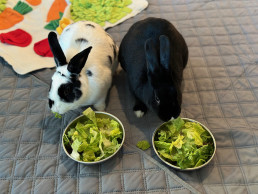GI Stasis
GI stasis, or ileus, is a condition in which the rabbit’s gastrointestinal system becomes sluggish or stops moving altogether. It can result from various factors, including poor diet, dehydration, stress, dental disease, or other painful underlying medical problems. The signs of stasis may include reduced or absent fecal output, decreased appetite, lethargy, and a hunched posture. True stasis is always a symptom of a more serious condition as opposed to a disease itself.
Here are steps to address a rabbit in stasis:
- Seek Veterinary Care: If you suspect your rabbit is suffering from stasis, consult a veterinarian experienced in treating rabbits. Prompt medical attention is essential to determine the underlying cause and initiate treatment.
- Hydration: Dehydration is a common cause for low/no appetite. Encourage your rabbit to drink water by providing clean, fresh water in a bowl, never a bottle. A veterinarian may also administer subcutaneous fluids to hydrate the rabbit.
- Proper Nutrition: Maintain a proper diet rich in fiber to stimulate the digestive system. Offer fresh hay and remove high-carbohydrate foods such as carrots, pumpkin and fruit from the diet.
- Pain Management: If your rabbit is in pain, your veterinarian may prescribe medication to alleviate discomfort.
- Gentle Movement and Exercise: Encourage your rabbit to move around to help stimulate their gut and break up any gas bubbles that may be trapped in the GI tract.
- Medication: In some cases, your vet may prescribe medications to stimulate gastrointestinal activity.
- Address the Underlying Cause: Stasis is a symptom of an underlying issue, such as dental disease, infection, liver lobe torsion, heart disease, E. Cuniculi, etc. Identify and address the root cause to prevent recurrence. Always request bloodwork and radiographs from your vet to get a proper diagnosis and to rule out obstruction.
- Prevention: To prevent future stasis episodes, provide a proper diet, maintain dental health, and create a stress-free environment for your rabbit.
What we don’t recommend :
- Force feeding critical care before a vet has ruled out obstruction with x-rays. This can cause more harm to your rabbit.
- Laxatone. The ingredients in laxatone do nothing beneficial for rabbit gut motility. Additionally, if there is dehydrated hair in the GI tract, feeding laxatone can coat the hair and inhibit hydration of the mass, making it less likely to move along through the GI tract. The main ingredient in Laxatone is petrolatum, which is a byproduct of gasoline and banned in the EU.
- Papaya and pineapple. The enzymes in these fruits can actually irritate the lining of the stomach of a rabbit who isn’t eating, again causing more harm than good. Fruit or any other high sugar food can be detrimental to a rabbit in stasis.
- Simethicone(baby gas drops.) The latest understanding amongst the most rabbit savvy vets is that simethicone does nothing beneficial for the type of gas rabbits produce. Encouraging your rabbit to move around will help break up any gas bubbles more efficiently.
- Abdominal massage. It’s possible to bruise internal organs while massaging the abdomen. Again, encouraging the bunny to move around will have the desired effect.
Stasis is a serious condition that requires immediate attention. Knowing the symptoms and acting promptly by consulting a rabbit-savvy veterinarian is vital. By following the prescribed treatment plan and maintaining a proactive approach to your rabbit’s health, you can help ensure a happy and healthy life for your beloved companion.
Source – https://www.ncbi.nlm.nih.gov/pmc/articles/PMC7258705/
Housing & Space Requirements
Rabbits are charming, intelligent companions who bring joy and warmth to our homes and should be given the same respect as cats and dogs. As responsible rabbit guardians, it is our duty to provide them with an environment that promotes both physical and mental well-being. We at HRS Chicago believe rabbits in North America are safest and happiest as indoor companions.
Understanding the Basics:
Indoor rabbit housing involves creating a space that mimics a rabbit’s natural habitat, allowing them to exhibit their natural behaviors. For folks who can’t let their rabbits free roam or live in a dedicated bunny room, creating a designated area with 2-3 exercise pens can be a good option. Rabbits should have the freedom to do zoomies and binkies at all times of the day, especially overnight when they are most active. Along with other rabbit welfare organizations, we are moving away from using single 4×4 pens for any length of time. This is not sufficient space for any rabbit. Keeping rabbits confined to a small pen can cause mental health problems like boredom and aggression. Being unable to run around freely leads to health issues such as arthritis, spondylosis, bladder sludge, and muscle wasting.
Space Requirements:
The Rabbit Welfare Association & Fund emphasizes the importance of providing sufficient space for rabbits to live comfortably. Their guidelines suggest a minimum of 10ft x 6ft of space for a pair of small to average sized rabbits. Larger breeds or more active rabbits will require even more space. This ensures that they have enough room to hop, run, stand on their hind legs, and stretch out – vital activities for their physical health and mental stimulation. Generally 30 inches is plenty of height to contain most rabbits in an indoor space, but occasionally you’ll need to invest in much taller pens for adventurous jumpers or climbers. Never ever lock a rabbit in a cage or a hutch for any length of time. Cages can be used as litter boxes if left open at all times but they can also cause territorial issues with bonded bunnies if they are enclosed. A hutch that’s left open 24/7 can be used as a hiding spot but keep in mind they can be very difficult to clean.
Creating a Stimulating Environment:
Rabbits are intelligent and curious creatures who still have most of their wild instincts and a well-designed indoor space can provide endless opportunities for mental stimulation. Incorporating tunnels, hides, dig boxes and a variety of toys can keep your rabbit engaged and prevent boredom. We suggest the use of cardboard boxes with entrances and exits as a way to mimic the burrows that rabbits would create in the wild. Rabbits also love to zoom through cat tunnels.
Additionally, providing platforms or ramps can add vertical space to the enclosure, allowing rabbits to explore and exercise their natural instinct to survey their surroundings. We cannot emphasize enough the importance of hiding places within the enclosure, as rabbits are prey animals and often feel safer when they have a secure space to retreat to.
Dig boxes can include shredded/crumpled paper or plastic balls. We do not recommend using sand in dig boxes as it can cause digestive upset if too much is ingested.
Baby stacking cups, plastic baby keys, wooden chews and puzzle toys are all great for providing mental stimulation and can prevent your rabbits from getting bored.
Location Matters:
Selecting an appropriate location for your rabbit’s indoor haven is crucial. We recommend choosing a quiet area away from excessive noise, any predatory pets, direct sunlight, and drafts. Rabbits are sensitive to their environment, and a peaceful location will help them feel secure and at ease.
Maintenance and Cleaning:
Maintaining a clean and hygienic living space is essential for the health of your rabbit. Regular spot cleaning and a thorough cleaning routine, including changing bedding and washing litter boxes, are vital aspects of rabbit care. Plain vinegar is a safe and effective cleaner for your rabbit’s space. If you’re not using litter box liners, it easily dissolves the calcium buildup in litter boxes as well.
Creating the perfect indoor housing for your rabbit involves thoughtful planning, incorporating elements to encourage their natural behaviors, and providing ample space for them to thrive. By following these basic guidelines, you can ensure that your rabbit not only survives but thrives in their indoor home. A happy and healthy rabbit is a joyous companion, and the effort you invest in their living space will be rewarded with years of happy and healthy bunnies!
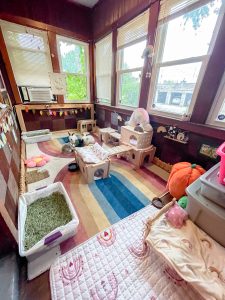
The Belden Buns
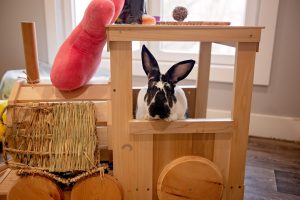
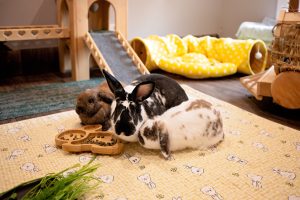
Agi Zeman’s trio
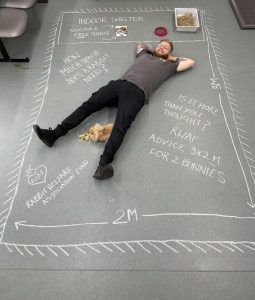
RWAF’s Space Recommendation
Diet
Hay! – The GRASS Roots of the Diet
Hay is essential for gut and dental health. It should make up the majority of the rabbit’s diet. Rabbits should have access to fresh grass hay at all times. They should never run out. Refresh/top off at least once daily and expect for some to be wasted every day. Timothy, meadow, orchard, oat, brome, bluegrass and fescue are all great options. Alfalfa is a legume hay, not a grass hay. Providing several varieties helps to build a robust cecal flora which will make your rabbit more resilient to GI upset. Since rabbits are natural foragers, they prefer to eat their hay from the ground as opposed to hay racks and feeders. They also like to have hay piles in several different spots in their space. Consider stuffing small empty boxes with hay and leaving them around their space.
Pellets – Nutritional Supplement
Young Rabbits
Young rabbits require extra nutrients while they’re growing. Feed unlimited plain pellets to young rabbits. Begin to limit pellets to ½ cup – 1 cup daily around 9 months.
Adult Rabbits
1/8 – 1/2 cup of grass hay based pellets daily – plain pellets, no muesli type mixes with colorful treats or seeds. We recommend Oxbow Garden Select, Supreme Science Selective House or Grain Free, Sherwood, and Small Pet Select.
Senior Rabbits
Often as rabbits age, they can have trouble maintaining their weight. When this happens, they will require extra calories to keep them healthy. Consider increasing their normal amount of pellets or switching to a senior alfalfa based formula.
Long hair breeds will also require extra nutrition/pellets to keep them healthy and maintain a normal weight.
Some vets tell people not to feed pellets or to just use them as treats. HRS Chicago does not agree with this because 1) they don’t explain fully that each rabbit is individual and some need more nutrition than others 2) if you are only going to feed hay and greens it has to be about 3 different types of hay daily and 8 different types of greens daily (mixed to make a huge salad) to ensure complete nutrition and 3) their weight has to be monitored to make sure as they age they maintain muscle mass. HRS Chicago feels that the best way to ensure complete nutrition is to feed limited amounts of high quality, grass hay based pellet food.
Leafy Greens – Variety is the spice of life!
Rabbits don’t eat just one type of green veg in nature so we shouldn’t be offering just romaine for them every day. They greatly benefit from multiple types of leafy greens in the diet.
Volume – for adults, feed about 1 cup of greens per 5lbs of bunny.
Baby rabbits can start eating salad with mom when they start eating solids, around 3 weeks.
Below are some safe greens for your rabbit:
- Spring mix
- Arugula
- Basil
- Bok choy
- Fennel
- Escarole
- Endive
- Parsley
- Cilantro
- Dandelion greens
- Broccoli rapini
- Carrot tops
- Kale
- Endive
- Watercress
- Beet tops
- Dill
- Romaine
- Green/red leaf lettuce
NOTE: While dietary calcium does NOT cause stones or sludge like many people believe, we recommend limiting or omitting spinach from the diet as it is high in oxalates.
It’s best to avoid fruit and sugary vegetables(carrots, pumpkin, sweet potatoes, etc) entirely. Rabbits have specialized digestive tracts to allow fermentation to take place for fiber to be digested by bacteria and broken down into absorb-able forms of nutrients. So the fiber that rabbits eat does nothing in the small intestine. It travels to the cecum where fermentation takes place. The bi-products of that digestion are volatile fatty acids. When you feed an appropriate ratio of fiber to carbs, or non-digestible fiber to simple sugars, a certain ratio of volatile fatty acids is produced.
When you overfeed fruits in the rabbit a few things happen to the digestive tract.
- The simple sugars are absorbed in the small intestine and affect appetite/motility hormones, most specifically motilin, which when carbs are overfed is under-produced and GI motility is slowed down.
- The ratio of VFA’s produced by the cecum changes, because the population of bacteria changes to favor bacteria that prefer simple sugars. This lowers the pH of the cecum which causes
- The veriform appendix to overproduce bicarbonate to buffer the cecal contents. Rabbits that are fed too high of carbohydrates have grossly larger appendixes, are more prone to GI stasis, and may become overweight or have problems with excessive cecotropes.
Water from a clean crock/bowl is best for optimum hydration. Never use a bottle for rabbits as they can cause dehydration, stasis, kidney disease, chipped teeth, choking and neck pain.
NOTE: For rabbits that have chronic GI problems, it may be beneficial to completely remove pellets and/or salad from the diet. Some rabbits are sensitive to grains (found in most pellets) and some cannot tolerate any fresh greens. Please consult your veterinarian with any questions about transitioning to modified diets.
NEVER FEED
- Potatoes
- Avocado
- Chocolate
- Onion/Garlic
- Muesli
- Millet
- Nuts/seeds
- Bread
- Corn
- Dairy/yogurt drops
BRANDS TO AVOID
- Kaytee
- Purina
- Vitakraft
- Small World
- Rosewood Naturals
Click here to download our Rabbit Diet Guide.
© House Rabbit Society of Chicago

